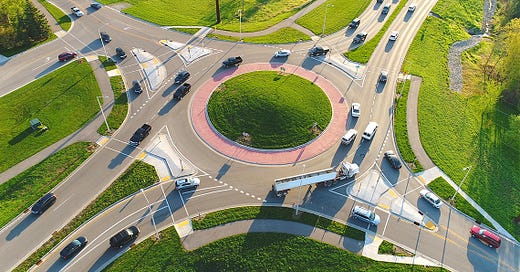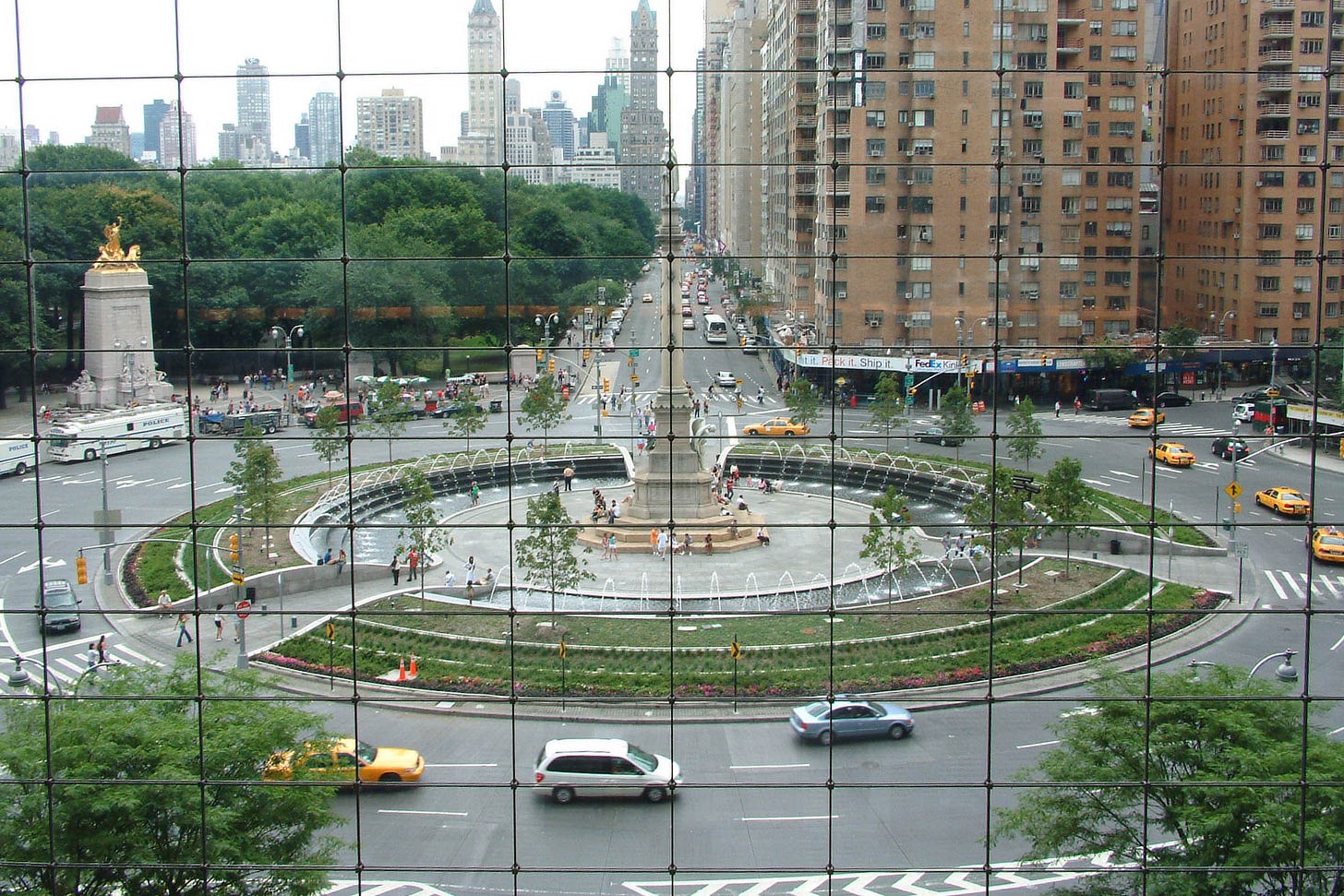A lot of my conservative-leaning friends have some choice epithets for me when they learn that I like roundabouts, you know, those traffic intersections where roads meet at circles. My favorite is probably “communist,” although “big-government liberal” and “European” also have a lot to recommend them.
To be fair, they are far more European than they are American. But then again, Europe/England and America are different in a million ways; it would be surprising indeed if there weren’t some where maybe we could learn something from them.
I was skeptical too at first. That’s why, when I first heard a traffic engineer I respect advocating for them, I decided to do a bit of a deep dive. So I did what I normally do when researching a new topic: find the strongest arguments from different perspectives.
And I couldn’t do it. I couldn’t find people arguing for the traffic-light intersections that we use. I found roundabouts being defended and promoted by YouTube content creators, Web 3.0 publishers like Cheddar, infrastructure enthusiasts, the Minnesota Local Road Research Board, and John Stossel. John Stossel’s might be my favorite; as one perceptive commenter noted,
I just want everyone to realize how much honesty stossel shows.
Stossel makes content about wasteful spending, it's pretty clear he went into this investigation to find out about these useless roundabouts that cost too much. But he found out differently, now here's where it gets important to recognize Stossel's reporting integrity. Unlike most 'journalists' who would scrap such a story because it disagrees with their narrative, stossel posts his findings to challenge even his own biases, which for 2021 is quite impressive.
Indeed, the arguments made when I first took this trip nearly a year ago have become the sort of things that I can’t help but notice now every time I’m in a car. So I want to launch into something of a soapbox—a list of reasons why I think roundabouts are better intersections and should be used more. I’m calling it a soapbox because I don’t plan on assembling my arguments with a lot of connective tissue or even ordering them in a maximally persuasive way—just letting loose, as though I were on a front-porch rocking chair with some hard cider in my hand and in my system.
Quick clarifier: some people use the term “roundabout” to refer to circular intersections of roads, like that pictures above, and also to those that do so while still incorporating traffic lights, like NYC’s Columbus Circle, pictured below. I think the two are worth distinguishing for a variety of factors (many of them are manifest in my list of advantages of roundabouts), so I hold with those who call unadorned circular intersections “roundabouts” and those that add electric traffic lights to that shape “traffic circles.”
But we’re here to talk about roundabouts.
No wasted time. One of the crucial ideas behind traffic lights is that if you want to travel straight ahead, they can keep you sitting there, sometimes for minutes, even if the coast is 100% clear. That’s wasteful and tedious, and it doesn’t have to be that way.
Left and U-turns are easier. Who among us has not had the excruciating experience of trying to turn left at a busy intersection? You might wind up waiting through multiple entire red light cycles before you have any chance, knowing the whole time that behind you is a stack of drivers feeling entitled to a “fast lane” that is at an absolute stand-still. Even if this specific traffic light has a green left arrow set aside for it, odds are that that’s necessary because it’s so heavily used—and will still necessitate multiple cycles if you aren’t driving at a totally off-peak hour. (That’s definitely been my experience.) Roundabouts, of course, obviate that significant problem: entering and exiting the roundabout is equally easy whether you’re turning left, going straight, or making a u-turn.
No game of “mother may I” with the government. This isn’t so much an argument as it is a response to the people who think that liking roundabouts somehow aligns me with the forces of larger/bigger/more government intrusion in our lives, because that’s so blatantly backwards. Yes, they happen to be more popular in places like France that have more bureaucracy and social welfare programs—also, France has pushed back against American ideological exports for being overly progressive and toxic. “People who claim to be progressive and who … distinguish people by the color of their skin are leading us to things that resemble fascism,” said France’s national education minister last year. In other words, being generally better doesn’t mean better at everything. And here in particular—is there anything other than that over-generalized appeal to buttress this opinion? Revisiting point (1), the traffic light intersections mean that the government can tell you, in your car, driving straight down an open road, to sit tight for 2 minutes just cuz. No one else is coming either way, but that doesn’t matter—your individual, specific, decentralized, ground-up knowledge means nothing. Because it is the government’s plan for you to spend the next 2 minutes sitting there at that red light. A roundabout, remember, is just roads going in a circle. You drive up to it and then you drive around it to find your branch, unless you need to yield for someone. No mother-may-I required. Again, I don’t actually think that this argument should weigh much at all—but if this dimension is going to be invoked, there is one infrastructure schema that makes individuals absurdly obsequious to the government and it’s not the roundabouts.
They are resilient to power outages. Out of intellectual honesty, I don’t want to overstate this one; the last time I came to a traffic-light intersection with a power outage (last year in rural Michigan), everything was pretty orderly and people took turns pretty nicely. But your system is still, at the end of the day, more secure when you know that you’re not going to be falling back on the kindness of strangers if your electricity goes out (something that seems to be talked about more and more lately). I could also add that roundabouts mean that the government doesn’t need to pay for that electricity, either, (since again, you just build the roads around a patch of grass, and that’s it), but I’m honestly not sure if that amounts to any sum worth writing home about. The math lecturer and popularizer Matt Parker once did a video noting, for example, that the UK government could perhaps come up with a cost-saving program that shaved 100 million pounds off the national budget—but if that means that each UK resident now takes home one pound and change (almost $2 as I write this) from that program, then that’s . . . not really significant.
They make odd intersections better to deal with. Think back to the last time that you were unlucky enough to encounter an intersection with two roads meeting at non-right angles. The visibility is worse, the signage might have been more confusing, and people’s driving was slightly less predictable. Or (and Milwaukee, WI, has plenty of these) think back to the last time that an intersection accommodated not 4 roads but some number more. These are predictable nightmares to deal with; wait times are bound to be long and, again, other drivers’ driving is less predictable. But neither of these are significant issues in a roundabout. In a roundabout, there is an initial (yielded) entrance, followed by driving for some arc of a circle, and then exiting: whether that’s 90, 180, 200, 48, or 134 degrees is irrelevant, as is whether you have 4 options to leave through or 3, 5, 6, or 9.
That is, for the present, what I have to say about that. You’ll notice that all of my points appealed to your lived (or imagined) experience when it comes to roundabouts—I didn't cite any statistics from studies that measured crashes or fatalities over time. I did so not because those numbers don’t exist (they do) or because they don’t support my argument (they do, and apparently changed Stossel’s mind on the subject), but because I think that these visual, personal points are going to stick with you more and do more to change your mind on the subject. Maybe, I don’t know. I do a lot of research but have a checkered record on convincing people and changing minds, so who knows. But if you’re the sort of person that read this and had a craving for numbers, I re-recommend Stossel’s video as a good synopsis of the quantitative research. Pax.




